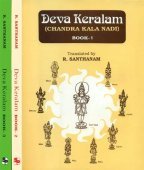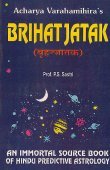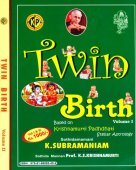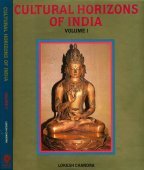Rashi, Rāsi, Rasi, Rāśi, Rāśī: 30 definitions
Introduction:
Rashi means something in Buddhism, Pali, Hinduism, Sanskrit, Jainism, Prakrit, the history of ancient India, Marathi, Hindi, biology, Tamil. If you want to know the exact meaning, history, etymology or English translation of this term then check out the descriptions on this page. Add your comment or reference to a book if you want to contribute to this summary article.
The Sanskrit terms Rāśi and Rāśī can be transliterated into English as Rasi or Rashi, using the IAST transliteration scheme (?).
Images (photo gallery)
In Hinduism
Purana and Itihasa (epic history)
Source: Cologne Digital Sanskrit Dictionaries: The Purana IndexRāśi (राशि).—Three-fold, as Brahmā, Rudra and Viṣṇu; (fourfold, according to another reading; see Wilson's translation).*
- * Viṣṇu-purāṇa VI. 8. 7.

The Purana (पुराण, purāṇas) refers to Sanskrit literature preserving ancient India’s vast cultural history, including historical legends, religious ceremonies, various arts and sciences. The eighteen mahapuranas total over 400,000 shlokas (metrical couplets) and date to at least several centuries BCE.
Vastushastra (architecture)
Source: McGill: The architectural theory of the MānasāraRāśī (राशी).—Besides āyādiṣaḍvarga, three other astrological principles are also mentioned in passing in the text (Mānasāra chapter 9), without always giving their full list or the formula to ascertain them: rāśī, “zodiacal sign”, gaṇa, literally, “cluster”, and nayana, literally, “eye”. The twelve rāśīs are, of course, familiar:
- Meṣa, Aries;
- Vṛṣabha, Taurus;
- Mithuna, Gemini;
- Kulīra, Cancer;
- Siṃha, Leo;
- Kanyā, Virgo;
- Tulā, Libra;
- Vṛścika, Scorpio;
- Dhanus, Sagittarius;
- Makara, Capricorn;
- Kumbha, Aquarius;
- Mīna, Pisces.
The text states that all of them except the eighth, Vṛścika, are auspicious.

Vastushastra (वास्तुशास्त्र, vāstuśāstra) refers to the ancient Indian science (shastra) of architecture (vastu), dealing with topics such architecture, sculpture, town-building, fort building and various other constructions. Vastu also deals with the philosophy of the architectural relation with the cosmic universe.
Vyakarana (Sanskrit grammar)
Source: Wikisource: A dictionary of Sanskrit grammarRāśi (राशि).—Usually used in the sense of a collection or a heap or a lunar constellation; the word is often used after the word वर्ण (varṇa) when it means the traditional collection of letters or the alphabet. The words अक्षरराशि, ब्रह्मराशि (akṣararāśi, brahmarāśi) and अक्षरसमाम्नाय (akṣarasamāmnāya) are also used in the same sense.

Vyakarana (व्याकरण, vyākaraṇa) refers to Sanskrit grammar and represents one of the six additional sciences (vedanga) to be studied along with the Vedas. Vyakarana concerns itself with the rules of Sanskrit grammar and linguistic analysis in order to establish the correct context of words and sentences.
Jyotisha (astronomy and astrology)
Source: Wisdom Library: Brihat Samhita by VarahamihiraRāśi (राशि) refers to the “Zodiacal signs” (representing a space of 30°), according to the Bṛhatsaṃhitā (chapter 2), an encyclopedic Sanskrit work written by Varāhamihira mainly focusing on the science of ancient Indian astronomy astronomy (Jyotiṣa).—Accordingly, “We shall now proceed to give a brief description of (the qualifications of) a jyotiṣaka. [...] He must know the Earth’s revolution round the sun and its rotation round its axis; its shape, size and the like; the latitude of a place and its complement; the nature of the hour circle; the cāra-dala-kāla [the difference between six hours and half a day], the times of the rising of the Zodiacal signs [i.e., rāśi-udaya]. He must also be able to calculate time from shadow and shadow from time and to convert longitude into right ascension and right ascension into longitude”.
Source: Wikibooks (hi): Sanskrit Technical TermsRāśi (राशि).—Zodiacal sign or 30 °. Note: Rāśi is a Sanskrit technical term used in ancient Indian sciences such as Astronomy, Mathematics and Geometry.

Jyotisha (ज्योतिष, jyotiṣa or jyotish) refers to ‘astronomy’ or “Vedic astrology” and represents the fifth of the six Vedangas (additional sciences to be studied along with the Vedas). Jyotisha concerns itself with the study and prediction of the movements of celestial bodies, in order to calculate the auspicious time for rituals and ceremonies.
Vaishnavism (Vaishava dharma)
Source: Pure Bhakti: Arcana-dipika - 3rd EditionRāśī (राशी) refers to “sun sign” or the “Vedic zodiac sign”:—The different signs of the zodiac through which the sun travels are mentioned below, and the approximate dates are given as well. For precise dates, please refer to a Vedic calendar.
- Meṣa or “aries” — (mid April to mid May);
- Vṛṣabha or “taurus” — (mid May to mid June);
- Mithuna or “gemini” — (mid June to mid July);
- Karkaṭa or “cancer” — (mid July to mid August);
- Siṃha or “leo” — (mid August to mid September);
- Kanyā or “virgo” — (mid September to mid October);
- Tulā or “libra” — (mid October to mid November);
- Vṛścika or “Scorpio” — (mid November to mid December);
- Dhanur or “Sagittarius” — (mid December to mid January);
- Makara or “capricorn” — (mid January to mid February);
- Kumbha or “aquarius” — (mid February to mid March);
- Mīna or “pisces” — (mid March to mid April );
In accordance with the zodiac sign the sun is situated in, one would utter, for example, meṣa-rāśī sthite bhāskare.

Vaishnava (वैष्णव, vaiṣṇava) or vaishnavism (vaiṣṇavism) represents a tradition of Hinduism worshipping Vishnu as the supreme Lord. Similar to the Shaktism and Shaivism traditions, Vaishnavism also developed as an individual movement, famous for its exposition of the dashavatara (‘ten avatars of Vishnu’).
Ayurveda (science of life)
Source: gurumukhi.ru: Ayurveda glossary of terms1) Rāśi (राशि):—Quantity; consists of Sarvagraha (total account), and Parigraha (individual account) which ascertain the results of the food taken in proper or improper quantity.
2) Rāśī (राशी):—A unit of Measurement; Synonym of one drona = 12. 288kg / l of metric units

Āyurveda (आयुर्वेद, ayurveda) is a branch of Indian science dealing with medicine, herbalism, taxology, anatomy, surgery, alchemy and related topics. Traditional practice of Āyurveda in ancient India dates back to at least the first millenium BC. Literature is commonly written in Sanskrit using various poetic metres.
Ganitashastra (Mathematics and Algebra)
Source: archive.org: Hindu Mathematics1) Rāśi (राशि) represents the number 12 (twelve) in the “word-numeral system” (bhūtasaṃkhyā), which was used in Sanskrit texts dealing with astronomy, mathematics, metrics, as well as in the dates of inscriptions and manuscripts in ancient Indian literature.—A system of expressing numbers by means of words arranged as in the place-value notation was developed and perfected in India in the early centuries of the Christian era. In this system the numerals [e.g., 12—rāśi] are expressed by names of things, beings or concepts, which, naturally or in accordance with the teaching of the Śāstras, connote numbers.
2) Rāśi (राशि) is used in the sense of “term” or “rule”, as in Trairāśika (“rule of three”), which represents one of the twenty operations (logistics) of pāṭīgaṇita (“science of calculation which requires the use of writing material—the board”), according to Pṛthudakasvāmī’s commentary on the Brāhmasphuṭasiddhānta by Brahmagupta, a Sanskrit treatise on ancient Indian mathematics (gaṇita-śāstra) and astronomy from the 7th century.—The Hindu name for the Rule of Three terms is trairāśika (“three terms”, hence “the rule of three terms”).—The term rāśi is used in the enumeration of topics of mathematics in the Sthānāṅgasūtra (c. 300 B.C.) (Sūtra 747). There it probably refers to the Rules of Three, Five, Seven, etc.
3) Rāśi (राशि) or Rāśigata refers to the “symbolical” (method of demonstration), according to the principles of Bījagaṇita (“algebra” or ‘science of calculation’).—The method of demonstration has been stated to be always of two kinds according to Bhāskara II in the Bījagaṇita:—“one geometrical (kṣetra-gata) and the other symbolical (rāśi-gata)”. We do not know who was the first in India to use geometrical methods for demonstrating algebraic rules. Bhāskara II (1150) ascribes it to ancient teachers.
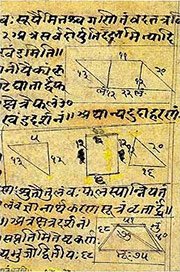
Ganitashastra (शिल्पशास्त्र, gaṇitaśāstra) refers to the ancient Indian science of mathematics, algebra, number theory, arithmetic, etc. Closely allied with astronomy, both were commonly taught and studied in universities, even since the 1st millennium BCE. Ganita-shastra also includes ritualistic math-books such as the Shulba-sutras.
Pancaratra (worship of Nārāyaṇa)
Source: Shodhganga: Kasyapa Samhita—Text on Visha Chikitsa (p)Rāśi (राशि) refers to “heaps (of cotton)”, according to the Garuḍopaniṣad (verse 8.5-8) which also describes the appearance of Garuḍa and advices the sādhaka to contemplate on such a Garuḍa in connection with the mantras and rituals prescribed for the removal of poison. Garuḍa who is the vehicle of Viṣṇu (viṣṇuvāha), who is adorned by nāgas and who destroys poison much like the fire which decimates heaps of cotton (tūla-rāśi) (Cf. Garuḍopaniṣad verse 8cd-9):

Pancaratra (पाञ्चरात्र, pāñcarātra) represents a tradition of Hinduism where Narayana is revered and worshipped. Closeley related to Vaishnavism, the Pancaratra literature includes various Agamas and tantras incorporating many Vaishnava philosophies.
In Buddhism
Mahayana (major branch of Buddhism)
Source: academia.edu: A Study and Translation of the GaganagañjaparipṛcchāRāśi (राशि) refers to a “heap (of jewels)”, according to the Gaganagañjaparipṛcchā: the eighth chapter of the Mahāsaṃnipāta (a collection of Mahāyāna Buddhist Sūtras).—Accordingly: “[...] At that time, the king Sarvadevābhiṣeka had paid homage and respect to the Lord for forty internal aeons (antarakalpa), making offerings of a heap of jewels (ratna-rāśi), as much as Mount Sumeru, every single day. By the firmness of his merits (puṇya), the king, his sons, his village’s people and retinues generated the thought of incomparable complete awakening. [...]”.

Mahayana (महायान, mahāyāna) is a major branch of Buddhism focusing on the path of a Bodhisattva (spiritual aspirants/ enlightened beings). Extant literature is vast and primarely composed in the Sanskrit language. There are many sūtras of which some of the earliest are the various Prajñāpāramitā sūtras.
In Jainism
General definition (in Jainism)
Source: The University of Sydney: A study of the Twelve ReflectionsRāśi (राशि) refers to a “heap (of jewels)”, according to Pūjyapāda’s Sarvārthasiddhi.—Accordingly, “[...] And even among the five-sensed beings, many belong to the animal world such as the cow, the deer, the bird, the serpent, etc. Hence human birth is as difficult of attainment as a heap of jewels (ratna-rāśi) at the crossing of the roads. And if one loses the condition of a human being by negligence, it is as difficult to attain it once again, as it is difficult for a burnt tree to regain its old freshness. Even if human birth is attained, a good country, a good family, keen senses, health, etc. are more and more difficult of attainment. [...]”.

Jainism is an Indian religion of Dharma whose doctrine revolves around harmlessness (ahimsa) towards every living being. The two major branches (Digambara and Svetambara) of Jainism stimulate self-control (or, shramana, ‘self-reliance’) and spiritual development through a path of peace for the soul to progess to the ultimate goal.
India history and geography
Source: Project Gutenberg: Castes and Tribes of Southern India, Volume 1Rasi (“zodiacal sign”) refers to a factor taken into consideration, by consulting an astrologer, before marriage among the Agamudaiyans (a cultivating case foundin all the Tamil districts).—Beginning from the girl’s zodiacal sign, the young man’s should be beyond the sixth.
Source: Cologne Digital Sanskrit Dictionaries: Indian Epigraphical GlossaryRāśi.—(IA 17), a sign of the zodiac. (IE 7-1-2), ‘twelve’. Cf. rāśi-ppon (SITI), also called rāśi-paṇam; explained as ‘pure gold’; probably, ‘current good coin.’ Note: rāśi is defined in the “Indian epigraphical glossary” as it can be found on ancient inscriptions commonly written in Sanskrit, Prakrit or Dravidian languages.

The history of India traces the identification of countries, villages, towns and other regions of India, as well as mythology, zoology, royal dynasties, rulers, tribes, local festivities and traditions and regional languages. Ancient India enjoyed religious freedom and encourages the path of Dharma, a concept common to Buddhism, Hinduism, and Jainism.
Biology (plants and animals)
Source: Google Books: CRC World Dictionary (Regional names)Rashi in India is the name of a plant defined with Sesamum indicum in various botanical sources. This page contains potential references in Ayurveda, modern medicine, and other folk traditions or local practices It has the synonym Capraria integerrima Miq. (among others).
Example references for further research on medicinal uses or toxicity (see latin names for full list):
· Monographs in Systematic Botany from the Missouri Botanical Garden (2007)
· Proceedings of the Indian Science Congress Association (1979)
· Acta Agriculturae Universitatis Pekinensis (1988)
· Bulletin of the Botanical Survey of India (1972)
· Journal of Cytology and Genetics (1996)
· Proceedings of the Indian Science Congress Association (1983)
If you are looking for specific details regarding Rashi, for example chemical composition, side effects, pregnancy safety, extract dosage, health benefits, diet and recipes, have a look at these references.

This sections includes definitions from the five kingdoms of living things: Animals, Plants, Fungi, Protists and Monera. It will include both the official binomial nomenclature (scientific names usually in Latin) as well as regional spellings and variants.
Languages of India and abroad
Pali-English dictionary
Source: BuddhaSasana: Concise Pali-English Dictionaryrāsi : (m.) a heap; quantity.
Source: Sutta: The Pali Text Society's Pali-English DictionaryRāsi, (Vedic rāśi) 1. heap, quantity, mass It. 17; usually —°, e.g. aṅgāra° heap of cinders J. I, 107; kaṇikārapuppha° of k. flowers VvA. 65; kahāpaṇa° of money PvA. 162, tila° of seeds VvA. 54; dhañña° of corn A. IV, 163, 170; etc.—rāsiṃ karoti to make a heap, to pile up Mhvs 29, 28; VvA. 157.—2. (store of) wealth, riches; in °agga-dāna gift of the best treasures (of one’s property), one of the 5 “donations of the best, ” viz. khett°, rās°, koṭṭh°, kumbhi°, bhojan°: SnA 270. See also °vaḍḍhaka — 3. a sign of the Zodiac (the 12, as given at Abhp 61 are: mesa, usabha, methuna, kakkata, sīha, kaññā, tulā, vicchikā, dhanu, makara, kumbha, mīna; or the ram, bull, twins, crab, lion, virgin, balance, scorpion bow, capricorn, waterpot, fish) PvA. 198.—4. (fig.) at t. t. in logic: group, aggregate, category, congery; frequent in Abhidhamma-literature, where 3 “accumulations” are spoken of, viz. micchatta-niyato rāsi, sammatta-niyato r. , anivato r. or “wrong doing entailing immutable evil results, that of well-doing entailing immutable good results, and that of everything not so determined” (Dialogues III, 210); D. III, 217; Kvu 611; Nett 96; cp. Kvu trsl. 356 Dhs. trsl. 26, 253. In the 5 factors of individuality (body and mind) khandhā are explained as meaning rāsi, e.g. Asl. 141; B. Psy. 42. In other connections: S. V, 146 (kusala°, akusala°), 186; A. III, 65 (akusala°); Tikp 45.—Note. In BSk. we find only 2 of the 3 categories mentioned at MVastu I. 175, viz. mithyātvaniyato & aniyato rāśih.

Pali is the language of the Tipiṭaka, which is the sacred canon of Theravāda Buddhism and contains much of the Buddha’s speech. Closeley related to Sanskrit, both languages are used interchangeably between religions.
Marathi-English dictionary
Source: DDSA: The Molesworth Marathi and English Dictionaryrāśi (राशि).—m (S) A sign of the zodiac. 2 f A heap or pile; any accumulation or mass. In this sense are numerous valuable compounds; as puṇyarāśi, pāparāśi, tējōrāśi, tapōrāśi, guṇarāśi. 3 An undistinguished multitude or mass; a promiscuous assemblage. 4 The figures or figure set down for an arithmetical operation; the addendum, multiplicand, dividend &c. 5 Sum, amount, total. 6 (As disting. from ākaṇa, nikaṇa, maṇī) The heap of corn, the produce of the first treading of the ears. See under madana. rāśī puñjīsa yēṇēṃ To fall to the heap or hoard; to arise as clear profit (after all expenses and costs are paid); to be bagged; to go to the stocking. rāśīvara At the heap (of thrashed corn); upon the thrashing floor. Ex. adamaṇa dāṇē kēlē karāra || tē mī dēīna rā0 ॥. rāśīsa basaṇēṃ or lāgaṇēṃ g. of o. To stand in inimical attitude against;--said of a planet. 2 To follow with inappeasable hostility, in order to accomplish the ruin of. 3 To sit (at the door &c.) with determined and dogged persistence in exaction of compliance with some demand; to hang upon assiduously in enforcement, injunction, or entreaty: also to study closely and intently.
--- OR ---
rāśī (राशी).—f The popular form or derivative of rāśi.
--- OR ---
rāśī (राशी).—a (rāśi or rāsa) Of the heap or mass; of the middling quality; middling. 2 Of the middle grade, neither male nor female, i. e neuter;--applied to an impotent.
Source: DDSA: The Aryabhusan school dictionary, Marathi-Englishrāśi (राशि).—m rāsa f A sign of the zodiac. f A heap. A sum. rāśīsa basaṇēṃ-lāgaṇēṃ Stand in inimical attitude against; hang upon assiduously in enforcement.
--- OR ---
rāśī (राशी).—a Of the heap; middling.
Marathi is an Indo-European language having over 70 million native speakers people in (predominantly) Maharashtra India. Marathi, like many other Indo-Aryan languages, evolved from early forms of Prakrit, which itself is a subset of Sanskrit, one of the most ancient languages of the world.
Sanskrit dictionary
Source: DDSA: The practical Sanskrit-English dictionaryRāśi (राशि).—m., f. [aśnute vyāpnoti, aś-iñ dhātoruḍāgamaśca; cf. Uṇādi-sūtra 4.132]
1) A heap, mass, collection, quantity, multitude; मृदुनि मृगशरीरे तूलराशाविवाग्निः (mṛduni mṛgaśarīre tūlarāśāvivāgniḥ) Ś1; धनराशिः, तोयराशिः, यशोराशिः (dhanarāśiḥ, toyarāśiḥ, yaśorāśiḥ) &c.
2) The numbers or figures put down for any arithmetical operation (such as adding, multiplying &c.)
3) A sign of the zodiac.
4) Mathematics; Ch. Up.7.1.2.
5) One-twelfth part of the ecliptic.
6) An astrological house.
Derivable forms: rāśiḥ (राशिः).
Source: Cologne Digital Sanskrit Dictionaries: Edgerton Buddhist Hybrid Sanskrit DictionaryRāśi (राशि).—m., group, collection; (1) (= Pali rāsi) applied to three groups or categories of (human) beings, called mithyātva-(or mithyatva-)-niyata, samyaktva-ni°, and aniyata, respectively (= Pali micchatta-niyata, sam- matta-ni°, ani°); Childers, [Pali Text Society’s Pali-English Dictionary], and Senart Mahāvastu i.517 (on 175.13—16) all wrongly apply the term to views or behavior instead of creatures. Very clear is Lalitavistara 400.2: trīn sattvarāśīn, ekaṃ mithyatvaniyatam, ekaṃ samyaktvani- yatam, ekam aniyatam; it is then explained that the first is fixed in falsity, permanently unable to know the doc- trine; the second in truth (they will learn the doctrine whether a Buddha preaches it to them or not); while the third is undetermined (they will learn the doctrine if they hear it preached, not otherwise); substantially the same is said in Mahāvastu iii.318.5 (reading mithyātva°); in Mahāvastu i.175.13—16 (verses), the group fixed in falsehood (mithyātva- niyato rāśiḥ) will fill up the undetermined group (aniyataṃ rāśiṃ) on Buddha's appearance, and the aniyato rāśiḥ will fill up the rāśiṃ samyak (= samyaktva-niyataṃ rāśiṃ); similarly Mahāvastu iii.347.4 ff.; saṃvarṇitaḥ samyaktvaniyato rāśir vivarṇito mithyātva-ni° rāśiḥ parigṛhīto (embraced, brought into the fold) 'niyata-rāśir Lalitavistara 351.9; in Mahāvastu i.316.17 read mithyatva-niyato rāśi(ṃ ? n. sg.) for corrupt mss. nityatva-; [Page455-a+ 71] samyaktva-niyata-rāśiḥ, mithyātva°, aniyata-r° Mahāvyutpatti 1737- 39; mithyātva° also Mahāvyutpatti 6830; sattva-rāśīnāṃ samyaktva- niyata-tāṃ ca, mithyātva-niyatatāṃ ca, ubhayatvāni- yatatāṃ ca yathābhūtaṃ prajānāti Daśabhūmikasūtra 76.1; the aniyata and mithyātvaniyata rāśi do not exist in Sukhāvatī, Sukhāvatīvyūha 44.15 f. (in 14 the people there are called niyatāḥ samyaktve); the 3 rāśi listed (with spelling mithyatva-) Hoernle [Manuscript Remains of Buddhist literature found in Eastern Turkestan] 21.1 (from Saṃgīti Sūtra); (2) there are also three rāśi, groups, of dharmas which are abhisaṃbuddha by a Tathāgata: Bodhisattvabhūmi 404.23, defined 24 ff. as arthopasaṃ- hitā dharmāḥ, anarthopasaṃhitāḥ, and naivārthopasaṃ- hitā nānarthopasaṃhitāḥ.
Source: Cologne Digital Sanskrit Dictionaries: Shabda-Sagara Sanskrit-English DictionaryRāśi (राशि).—m.
(-śiḥ) 1. A heap, a quantity. 2. A sign of the zodiac. 3. Arithmetical or algebraic quantity. 4. A part and its divisor or numerator and denominator. 5. A congeries of number or quantity. E. aś to pervade, iṇ Unadi aff., and ruṭ initial augment; or raś to sound, with the same aff.
Source: Cologne Digital Sanskrit Dictionaries: Benfey Sanskrit-English DictionaryRāśi (राशि).—m. 1. A heap, a quantity, [Pañcatantra] 121, 11; 203, 7. 2. A sign of the zodiac.
Source: Cologne Digital Sanskrit Dictionaries: Cappeller Sanskrit-English DictionaryRāśi (राशि).—[masculine] heap, mass, multitude.
Source: Cologne Digital Sanskrit Dictionaries: Monier-Williams Sanskrit-English Dictionary1) Rāśi (राशि):—a m. ([cf. Lexicographers, esp. such as amarasiṃha, halāyudha, hemacandra, etc.] also f.; once [metri causa] in [Rāmāyaṇa] f(ī). ; derivation doubtful, but cf. [Uṇādi-sūtra iv, 32]) a heap, mass, pile, group, multitude, quantity, number, [Ṛg-veda] etc. etc.
2) (in [arithmetic]) a sum or the figure or figures put down for an operation (such as multiplying, dividing etc.), [Colebrooke]
3) a measure of quantity (= droṇa), [Śārṅgadhara-saṃhitā]
4) a sign of the zodiac (as being a certain sum or quantity of degrees), one-twelfth part of the ecliptic, an astrological house, [Mahābhārata; Varāha-mihira’s Bṛhat-saṃhitā] etc. (cf. [Indian Wisdom, by Sir M. Monier-Williams 178])
5) b a division of beings, [Sukhāvatī-vyūha i].
6) a heap of corn, [cf. Lexicographers, esp. such as amarasiṃha, halāyudha, hemacandra, etc.]
7) Name of an Ekāha, [???]
8) Rāśī (राशी):—[from rāśi] in [compound] for rāśi.
Source: Cologne Digital Sanskrit Dictionaries: Yates Sanskrit-English DictionaryRāśi (राशि):—(śiḥ) 2. m. A heap; a sign of the zodiac; quantity.
[Sanskrit to German]
Sanskrit, also spelled संस्कृतम् (saṃskṛtam), is an ancient language of India commonly seen as the grandmother of the Indo-European language family (even English!). Closely allied with Prakrit and Pali, Sanskrit is more exhaustive in both grammar and terms and has the most extensive collection of literature in the world, greatly surpassing its sister-languages Greek and Latin.
Hindi dictionary
Source: DDSA: A practical Hindi-English dictionaryRāśi (राशि):—(nf) a sum, amount; quantity; heap; sign of the zodiac; ~[cakra] zodiac; ~[nāma] the name given according to the relevant sign of the zodiac; —[ānā] to prove favourable, to be beneficial; —[milanā] to be agreeably inclined to each other by temperament; to be born in mutually concordant signs of the zodiac.
...
Kannada-English dictionary
Source: Alar: Kannada-English corpusRāśi (ರಾಶಿ):—
1) [noun] a collection of objects or material piled up so as to form a high (usu. conical) mass.
2) [noun] a gathering of a large number of people, animals, things, etc. at a place; a multitude; a crowd.
3) [noun] much quantity.
4) [noun] that which is of medium quality.
5) [noun] (astrol.) any of the twelve mansions of the zodiac.
6) [noun] (astron.) any of twelve imaginary belt in the heavens extending for about eight degrees on either side of the apparent path of the sun and including the paths of the moon and the principal planets (each named after a different constellation).
7) [noun] a quantity used in mathematics as in adding, subtracting, dividing or multiplying.
--- OR ---
Rāsi (ರಾಸಿ):—[noun] = ರಾಸು [rasu]1.
--- OR ---
Rāsi (ರಾಸಿ):—[noun] = ರಾಶಿ - [rashi -] 1, 5 & 6.
Kannada is a Dravidian language (as opposed to the Indo-European language family) mainly spoken in the southwestern region of India.
Tamil dictionary
Source: DDSA: University of Madras: Tamil LexiconRasi (ரஸி) [rasittal] 11 verb < ras. intransitive To be pleasing to the senses. See இரசி-. [irasi-.] — transitive To enjoy; அனுபவித்தல். [anupavithal.]
Tamil is an ancient language of India from the Dravidian family spoken by roughly 250 million people mainly in southern India and Sri Lanka.
See also (Relevant definitions)
Starts with (+31): Rashi-mitra, Rashi-pana, Rashi-panam, Rashi-ppon, Rashibhaga, Rashibhaganubandha, Rashibhagapavaha, Rashibhavishya, Rashibheda, Rashibhoga, Rashibhu, Rashibhuta, Rashibhutadhana, Rashicakra, Rashichakra, Rashicikkani, Rashidashaphala, Rashigata, Rashighatita, Rashijanmanakshatragrahanashanti.
Ends with (+151): Abhavasvabhavarashi, Aderashi, Adirashi, Agnirashi, Alarashi, Allarashi, Ambhorashi, Amborashi, Amburashi, Amerika-yama-narashi, Anantarashi, Ankarashi, Anurashi, Aparambhorashi, Aparamburashi, Aranyarashi, Arashi, Artharashi, Astarashi, Avitatharashi.
Full-text (+351): Rashibhuta, Ekarashi, Rashikrita, Rashikarana, Rashicakra, Taporashi, Kanya, Avyaktarashi, Vrishcika, Jalarashi, Tula, Varirashi, Rashibhaga, Rashibhu, Kshetrarashi, Makara, Dhanus, Mina, Rashigata, Rashibhutadhana.
Relevant text
Search found 72 books and stories containing Rashi, Rāsi, Rasi, Rāśi, Rāśī, Raashi; (plurals include: Rashis, Rāsis, Rasis, Rāśis, Rāśīs, Raashis). You can also click to the full overview containing English textual excerpts. Below are direct links for the most relevant articles:
Karmic Astrology—a Study (by Sunita Anant Chavan)
Part 2.2.10 - Horā period of Jyotiḥśāstra (Introduction) < [Chapter 2 - Jyotiḥśāstra and the Concept of Karman]
Part 4.2 - Jyotiḥśāstra in the Vedāṅga Period < [Chapter 3 - Development of Jyotiḥśāstra and Karman in the Literature]
Part 5.2 - Jyotiḥśāstra in the Varāha Period < [Chapter 3 - Development of Jyotiḥśāstra and Karman in the Literature]
Shrimad Bhagavad-gita (by Narayana Gosvami)
Verse 11.17 < [Chapter 11 - Viśvarūpa-darśana-yoga (beholding the Lord’s Universal Form)]
Chaitanya Bhagavata (by Bhumipati Dāsa)
Verse 2.28.9 < [Chapter 28 - The Lord’s Pastime of Accepting Sannyāsa]
Verse 1.3.10 < [Chapter 3 - Calculation of the Lord’s Horoscope]
Verse 2.8.208 < [Chapter 8 - The Manifestation of Opulences]
Cidgaganacandrika (study) (by S. Mahalakshmi)
Verse 37 [Bindu and Visarga] < [Chapter 2 - Second Vimarśa]
Philosophy of Charaka-samhita (by Asokan. G)
Composite man (rāśi-puruṣa) < [Chapter 5 - The Complete Man]
World Construction (Sāṃkhya and Caraka) < [Chapter 3 - Fundamental Theories]
The Garuda Purana (by Manmatha Nath Dutt)
Chapter LXII - Discourses on Lagnamana < [Agastya Samhita]
Chapter LIX - Discourses on Astrology < [Agastya Samhita]
Related products






